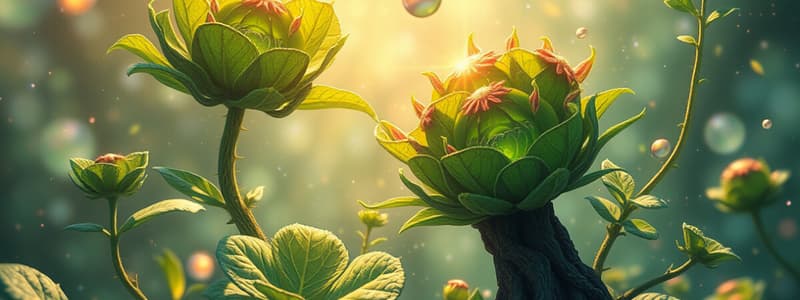Podcast
Questions and Answers
What process leads to the production of ATP in the light-dependent reaction?
What process leads to the production of ATP in the light-dependent reaction?
- Photophosphorylation (correct)
- Photoionisation
- Photolysis
- Electron transport
Which of the following molecules is NOT produced during non-cyclic photophosphorylation?
Which of the following molecules is NOT produced during non-cyclic photophosphorylation?
- ATP
- Glucose (correct)
- Reduced NADP
- Oxygen
Which statement accurately describes photolysis in the light-dependent reaction?
Which statement accurately describes photolysis in the light-dependent reaction?
- It splits water into protons, electrons, and oxygen. (correct)
- It excites electrons in chlorophyll.
- It generates glucose from carbon dioxide.
- It produces ATP from ADP.
What is the role of electron carriers in the light-dependent reaction?
What is the role of electron carriers in the light-dependent reaction?
During the light-dependent reaction, what happens to water molecules?
During the light-dependent reaction, what happens to water molecules?
Where does the Calvin cycle take place in the chloroplast?
Where does the Calvin cycle take place in the chloroplast?
What initiates the process of photoionisation in the light-dependent reaction?
What initiates the process of photoionisation in the light-dependent reaction?
What is formed when protons move down their concentration gradient during the light-dependent reaction?
What is formed when protons move down their concentration gradient during the light-dependent reaction?
Which of the following describes the primary product of the light-dependent reactions that is utilized in the Calvin cycle?
Which of the following describes the primary product of the light-dependent reactions that is utilized in the Calvin cycle?
What is the process called by which light energy splits water molecules?
What is the process called by which light energy splits water molecules?
Which organelle is responsible for photosynthesis in plant cells?
Which organelle is responsible for photosynthesis in plant cells?
What are the stacks of thylakoids in chloroplasts called?
What are the stacks of thylakoids in chloroplasts called?
Which photosystem absorbs light best at a wavelength of 700 nm?
Which photosystem absorbs light best at a wavelength of 700 nm?
What is the gel-like substance surrounding the thylakoids in chloroplasts called?
What is the gel-like substance surrounding the thylakoids in chloroplasts called?
What does the term 'oxidation' refer to in a redox reaction?
What does the term 'oxidation' refer to in a redox reaction?
Which coenzyme is involved in photosynthesis by transferring hydrogen?
Which coenzyme is involved in photosynthesis by transferring hydrogen?
Which of the following statements about chlorophyll is true?
Which of the following statements about chlorophyll is true?
What is the relationship between oxidation and reduction in redox reactions?
What is the relationship between oxidation and reduction in redox reactions?
Where are photosystems located within the chloroplast?
Where are photosystems located within the chloroplast?
Which of the following best describes the function of NADP in photosynthesis?
Which of the following best describes the function of NADP in photosynthesis?
Flashcards are hidden until you start studying
Study Notes
Chloroplast Structure and Function
- Photosynthesis occurs in chloroplasts, organelles surrounded by a double membrane.
- Thylakoids are fluid-filled sacs within chloroplasts, stacked into structures called grana (granum singular).
- Grana are interconnected by thylakoid membranes known as lamellae.
- Chloroplasts contain pigments like chlorophyll a, chlorophyll b, and carotene, key for light absorption.
- Photosystems (I and II) capture light energy; PSI is optimal at 700 nm wavelength.
- Surrounding thylakoids is the stroma, a gel-like substance containing enzymes, sugars, and organic acids.
Redox Reactions
- Redox reactions involve processes of oxidation (loss of electrons) and reduction (gain of electrons).
- Oxidation may also entail loss of hydrogen or gain of oxygen.
- Reduction may involve gaining hydrogen or losing oxygen.
- Coenzymes, like NADP, assist enzymes by transferring chemical groups between molecules.
Light-dependent Reactions
- These reactions require light energy and occur in the thylakoid membranes.
- Light energy excites electrons in chlorophyll, resulting in photoionization, changing chlorophyll into a positively charged ion.
- Energy from excited electrons is used to:
- Produce ATP from ADP (photophosphorylation).
- Generate reduced NADP from NADP.
- Split water (H2O) into protons, electrons, and oxygen (photolysis).
- Oxygen produced during photolysis is released as a byproduct.
Light-independent Reactions (Calvin Cycle)
- Do not directly use light energy but depend on ATP and reduced NADP from light-dependent reactions.
- Take place in the stroma and utilize energy and hydrogen to convert CO2 into glucose.
Non-cyclic Photophosphorylation
- Produces ATP, reduced NADP, and oxygen through an electron transport chain formed by linked photosystems and electron carriers.
- Key steps include:
- Excitation of electrons in PSII, leading to higher energy levels.
- Photolysis of water, generating protons (H+), electrons, and oxygen to replace lost electrons in the chlorophyll.
- Utilization of energy from excited electrons to create a proton gradient, facilitating ATP synthesis via ATP synthase.
Summary of Key Processes
- Photophosphorylation: Adding phosphate to ADP to form ATP using light energy.
- Photolysis: Splitting of water using light energy into protons, electrons, and oxygen.
- Electron Transport Chain: A series of proteins that transfer excited electrons, generating ATP and reduced NADP.
Studying That Suits You
Use AI to generate personalized quizzes and flashcards to suit your learning preferences.



